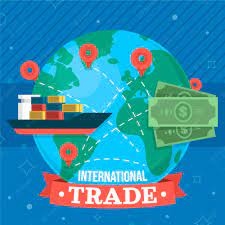
International trade is the exchange of goods, services, and capital across national borders, encompassing imports and exports between countries. It plays a pivotal role in the interconnectedness of nations, enabling them to specialize in producing goods and services efficiently while accessing a wider range of products and resources.
With the world becoming increasingly globalized, international trade has grown in significance, shaping economies and driving economic growth.
International trade occurs when countries engage in the exchange of goods, services, and capital. This exchange is driven by the principle of comparative advantage, which suggests that countries should specialize in producing goods or services in which they have a lower opportunity cost compared to others.
By doing so, countries can allocate their resources efficiently, increase productivity, and maximize overall output.
Trade takes place through exports and imports. Exports refer to goods, services, and capital sent out of a country to another, while imports denote the goods, services, and capital acquired from abroad. Trade can be bilateral (between two countries) or multilateral (involving multiple countries).
It can be conducted through various channels, including direct sales, licensing agreements, joint ventures, and foreign direct investment (FDI).
International trade holds immense significance for economies worldwide. Here are some key reasons why it is vital:
Economic Growth: International trade promotes economic growth by allowing countries to access a broader market for their goods and services. It fosters competition, drives innovation, and encourages specialization, leading to increased productivity and efficiency.
Resource Allocation: Trade enables countries to allocate their resources efficiently. By specializing in the production of goods or services in which they have a comparative advantage, countries can concentrate their resources on specific industries, leading to higher output and resource optimization.
Consumer Benefits: International trade expands the variety of goods and services available to consumers. It allows people to access products that are not produced domestically or are available at lower prices from abroad. This increases consumer choice, enhances standards of living, and provides access to a wider range of quality goods.
Job Creation: Trade stimulates employment opportunities by generating new jobs in export-oriented industries. It encourages investments and the growth of industries that cater to global demand, leading to increased employment and higher incomes.
Foreign Exchange: International trade generates foreign exchange earnings for countries through export revenues. These earnings contribute to strengthening the balance of payments, supporting currency stability, and facilitating international transactions.
Cooperation and Interdependence: Trade fosters cooperation and interdependence among nations. It encourages dialogue, diplomacy, and the establishment of trade agreements and organizations to regulate and facilitate trade, promoting peaceful relations and reducing the likelihood of conflicts.
The outbreak of the COVID-19 pandemic in late 2019 and its subsequent global spread have had far-reaching consequences on various aspects of society.
One area significantly impacted by the virus is international trade. The imposition of lockdowns, travel restrictions, and disruptions in supply chains have all contributed to a significant decrease in trade activities worldwide.
This article aims to assess the effects of COVID-19 on international trades, exploring the challenges faced by global economies, the shifts in trade patterns, and the potential long-term implications.
Disruptions in Global Supply Chains
One of the major impacts of COVID-19 on international trades has been the disruption of global supply chains. The virus originated in Wuhan, China, a major manufacturing hub for various industries.
As the virus spread, factories were forced to shut down, leading to a significant decrease in production. This disruption rippled through supply chains, affecting businesses worldwide that rely on components and raw materials from China.
The disruptions in supply chains were further exacerbated by lockdown measures imposed in different countries. Restrictions on movement and the closure of non-essential businesses hindered the transportation of goods, causing delays and shortages.
The closure of ports, airports, and land borders further complicated the logistics of international trade, making it difficult for companies to import and export goods.
Shifts in Trade Patterns
The COVID-19 pandemic has also led to notable shifts in trade patterns. As countries implemented lockdowns, consumer demand for certain goods changed dramatically. Non-essential items such as luxury goods, apparel, and electronics experienced a significant decline in demand, while there was an increased demand for essential goods such as medical supplies, personal protective equipment (PPE), and food.
Moreover, travel restrictions and reduced tourism impacted service-based economies heavily reliant on international visitors. Countries like Thailand, Spain, and Italy, which heavily rely on tourism, experienced a substantial decline in revenue.
On the other hand, e-commerce and digital services witnessed a surge in demand as people turned to online shopping and remote work.
Economic Contraction and Trade Decline
The economic contraction caused by the pandemic has had a severe impact on global trade. The International Monetary Fund (IMF) projected a global economic contraction of 3.5% in 2020, marking the worst recession since the Great Depression.
This decline in economic activity resulted in a significant drop in international trade volumes.
According to the World Trade Organization (WTO), the volume of world merchandise trade in 2020 experienced a decline of 5.3%, which is less severe than initially anticipated due to a rebound in the second half of the year.
However, this decline in trade was still significant, reflecting the challenges faced by economies worldwide.
Protectionist Measures and Trade Wars
In response to the disruptions caused by the pandemic, some countries resorted to protectionist measures and trade barriers. The desire to safeguard domestic industries and reduce dependency on foreign goods led to the implementation of export restrictions and import tariffs.
This rise in protectionism threatens the principles of free trade and hampers global economic recovery.
Moreover, the pandemic coincided with pre-existing trade tensions between major economies, most notably between the United States and China. These tensions escalated into a trade war, with both countries imposing tariffs on each other's goods.
The COVID-19 pandemic further exacerbated these tensions, straining international relations and complicating global trade dynamics.
Long-Term Implications
The effects of COVID-19 on international trade are likely to have long-term implications. The pandemic has highlighted the vulnerabilities in global supply chains and the risks associated with overreliance on a single country or region.
As a result, there is an increased focus on reshoring or diversifying supply chains to enhance resilience and reduce future disruptions.
Additionally, the pandemic has accelerated digitalization and e-commerce adoption. Businesses and consumers have increasingly embraced online platforms for trade, leading to a transformation in business models and supply chain management.
This shift towards digital trade is likely to continue even after the pandemic subsides, shaping the future of international commerce.
The COVID-19 pandemic has posed unprecedented challenges to international trade. Disruptions in global supply chains, shifts in trade patterns, economic contractions, and the rise of protectionist measures have all contributed to a significant decline in trade volumes.
However, the crisis has also highlighted the need for resilience, diversification, and digitalization in global trade. As countries and businesses adapt to the new normal, the long-term implications of the pandemic on international trade will continue to shape the future of the global economy.






















